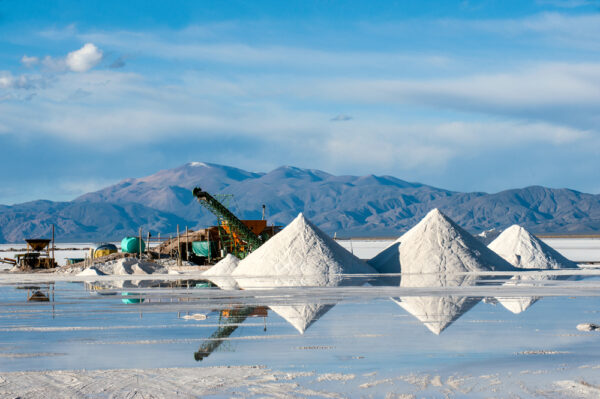The race is on in the United States to generate more lithium.

To meet its renewable energy ambitions, the United States will require significantly more lithium, and the industry that mines, extracts, and processes the chemical element is set to expand. Environmentalists, Indigenous groups, and government authorities have all raised concerns about the project.
Despite the fact that lithium reserves are found all over the world, the United States only has one working lithium mine, in Nevada. The element is essential for the development of rechargeable lithium-ion batteries, which are viewed as crucial for lowering climate-changing carbon emissions produced by automobiles and other modes of transportation.

In 2020, global lithium demand was over 350,000 tons (317,517 metric tons), but industry projections suggest demand may be up to six times higher by 2030. In areas including Maine, North Carolina, California, and Nevada, new and potential lithium mining and extraction projects are in various phases of development.
Tim Crowley, vice president of government affairs for Lithium Nevada, a subsidiary of a business planning a mine in Thacker Pass, Nevada, said, “Nobody really predicted this big jump in demand.” “For a long period, we owned the lithium space, and we gave it up to China.”
South America and Australia supply the majority of the world’s lithium, and China controls the lithium-ion battery supply chain. Although it holds roughly 4% of the world’s lithium reserves, the United States generates less than 2% of the world’s lithium supply. Chile has the world’s greatest oil reserves.

Open pit mining or brine extraction, which includes pumping a mineral-rich brine to the surface and processing it, would be used to increase domestic lithium output. The Sierra Club, for example, has expressed worry that the projects could endanger sacred Indigenous territories as well as delicate ecosystems and species.
However, according to Glenn Miller, retired professor of environmental studies at the University of Nevada, the initiatives could improve the environment in the long term by getting fossil fuel-burning cars off the road.
“A domestic source has tremendous value. Then we can do things that only China is doing with production,” Miller replied.

More than 200 years ago, Swedish chemist Johan August Arfwedson discovered lithium, the lightest element on Earth. Lithium and its derivatives have since been employed in a variety of applications, ranging from mental medicine to lubricating grease.
However, lithium’s popularity has soared in recent years due to its use in rechargeable batteries for electric and hybrid cars, lawnmowers, power tools, and other applications. Laptops and cell phones are also powered by lithium batteries.
The Biden administration has made a proposal to build half a million electric vehicle charging stations a centerpiece of its infrastructure plans. This initiative, as well as the rise of electric vehicle firms like Tesla, will necessitate significantly more lithium for battery production.
Lithium Americas has proposed a new lithium mining project for Thacker Pass, which is nearing completion. The mine in northern Nevada would produce millions of tons of lithium, but Native American groups have said it should be banned since it is located on holy land.
According to Lithium Americas CEO Jonathan Evans, construction might begin later this year, and it would be the first lithium project on federal territory in six decades.
Because of the increased need, Evans believes there will be more attempts to mine lithium in the United States. “It has been a small industry and it has grown quickly,” he explained “I do expect larger companies to enter the space via acquisitions or other means.”
Ioneer, based in Australia, also plans to create a massive lithium mine in Nevada that will generate 22,000 tons (19,958 metric tons) of lithium per year, enough to power hundreds of thousands of electric vehicles.
Environmentalists are concerned about lithium mining operations because they promise decarbonization in exchange for significant impacts on ecosystems and local communities. The Sierra Club has suggested that lithium mining could harm water quality and ranches in some areas.
The key challenge, according to Lisa Belenky, senior counsel for the Center for Biological Diversity, is ensuring that lithium mines are located in areas where they cause the least amount of damage.
“It really is very site specific as far as what impacts it would have to the local species, water,” Belenky stated. “Almost every energy project we look at for climate change has its own greenhouse gas footprint.”
The push for more local lithium has created opportunities for mining and extraction in states other than Nevada. Piedmont Lithium, an Australian business, has proposed an open-pit mining project for the Kings Mountain area west of Charlotte, North Carolina. According to the firm, the area was a key supplier of lithium from the mid-twentieth century to the 1980s.
The salty and diminishing Salton Sea, California’s largest lake, is also ripe for lithium mining. Lithium can be recovered from geothermal brine, and geothermal stations have been pumping brine for decades in the Salton Sea. Lithium extraction from the lake, according to proponents, would require less land and water than other brining projects.
According to a spokeswoman for EnergySource Minerals, one of the projects will be operating next year. General Motors Corp. is also a shareholder in a Salton Sea project that could begin producing lithium as early as 2024.
California’s lithium, according to Democrat Gov. Gavin Newsom, can help the state become a leader in battery manufacturing. During a January speech, he referred to the state as the “Saudi Arabia of lithium.”
Lithium is becoming a “increasingly vital resource,” according to Dee Dee Myers, a senior advisor to Newsom who focuses on business, as California and the rest of the world pursue sustainable energy development to mitigate the effects of climate change.
Given the resources near the Salton Sea, the state has the potential to create “epic quantities of lithium,” according to Myers. However, she stated that the company wants to ensure that lithium is harvested and produced in a sustainable manner.

The state government could be able to help regulate the extraction process. California also established the Lithium Valley Commission in 2020 to study and analyze lithium production incentives. By October, they must submit a report detailing their findings.
Plumbago Mountain, located in the western region of Maine, has sparked mining interest. According to a research published in the scientific journal Mineralium Deposita in 2020, the mountain is “a potentially important new lithium resource” with a greater average lithium content than similar deposits throughout the world.
Maine mining restrictions, on the other hand, may make it difficult to harvest the lithium. According to state mining coordinator Mike Clark, the Maine Department of Environmental Protection is looking into the prospect of quarrying for lithium at Plumbago at the request of the property’s owners.
According to Alicia Cruz-Uribe, an associate professor of petrology and mineralogy at the University of Maine, Plumbago Mountain is the type of location that might be crucial for the United States as it strives to meet its clean energy goals.
According to Cruz-Uribe, the country’s lithium reserves are among the world’s greatest. “But the amount that we produce is peanuts.”
This piece was written by Staff Writer on April 2, 2022. It originally appeared in DrewBerquist.com and is used by permission.
The opinions expressed by contributors and/or content partners are their own and do not necessarily reflect the views of LifeZette.

Join the Discussion
COMMENTS POLICY: We have no tolerance for messages of violence, racism, vulgarity, obscenity or other such discourteous behavior. Thank you for contributing to a respectful and useful online dialogue.
Can we mine lithium in the US , under the seas, Moon, Mars?
ID states & regions for ore? Sign treaties to mine & share ore
Reproduce synthetic lithium like we do diamonds?
Can more be done